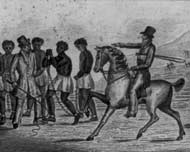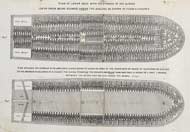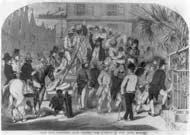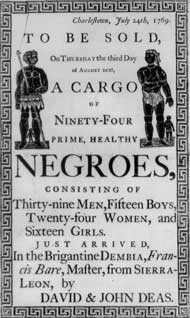Rice and Slavery
There is no question that rice had an overwhelming impact on the economy and society of the Lowcountry and the state. Rice took a dramatic hold on the Carolina economy between 1695 and 1715. During the same time, the population of enslaved Africans increased, so that by 1708 enslaved people outnumbered Europeans. The dramatic rise in the number of Africans imported into Charleston corresponds directly with the enormous rise in rice production. By 1715, Charles Town exported around 8,000 barrels of rice annually – that number increased to 40,000 barrels by the 1730s. At the same time the number of Africans in the colony increased from 4,100 people 1708 to nearly 40,000 people in 1740.
| Rice Exports | |
|---|---|
| 1700 | 12,000 lbs of rice |
| 1730 | 18,000,000 lbs of rice |
| 1770 | 83,000,000 lbs of rice |
| Legal Slave Imports into Charleston | |
|---|---|
| 1706-1723 | 4,504 people |
| 1724-1739 | 32,233 people |
| 1749-1787 | 68,701 people |
| 1804-1807 | 29,491 people |
From 1706 to 1739 over 36,000 Africans were imported into the colony directly from Africa, enduring the horrific Middle Passage across the Atlantic to fill the unending need for plantation labor. Over 10 million people were shipped across the Atlantic to the New World and many more people died during their initial capture and transport to the coast. Forty percent of the people imported into North America were brought through the port of Charleston. While the direct importation of people from the African continent was finally banned in 1808, it did not end the institution of slavery in the United States. By 1860, nearly 4 million people were enslaved in this country. In 1863, President Lincoln issued an executive order freeing all enslaved people in 10 southern states. The Proclamation went into immediate effect in Union-occupied areas. As the Union armies advanced through the Confederacy, thousands of slaves were freed each day. Slavery in the United States was officially abolished in 1865 by the 13th Amendment to the Constitution.
Carolina planters preferred people from West Africa, particularly what was then called the Windward Coast or Rice Coast. This region included Senegambia, Guinea, Sierra Leone, Ivory Coast, Gold Coast, and Benin, although people were also captured from Congo and Angola. These were the rice-growing regions of Africa. Captives from these areas knew how to build fields, control water, and plant and process the rice. Rice was grown in Africa for hundreds of years before it became a Carolina commodity. Historians believe much of the technology for controlling water such as the early rice trunks or plugs were African innovations.
Enslaved people who lived on Lowcountry rice plantations worked under the task system. They did not labor for a set number of hours per day. Instead, slaves were assigned a daily task. Historians believe that over the years slaves were able to negotiate the amount of work in these set tasks and these tasks became standardized across much of the Lowcountry. The amount of work in a task was based on the gender and age of the slave. Once the task was completed, slaves could stop work for the day. This gave enslaved people a small portion of each day to take care of their own homes, families, and gardens.
Typical Tasks
Hoeing rice: ½ acre
Harvesting rice: ¾ acre cutting or ½ acre cut and tie half
Threshing rice by flail: men 500 sheaves; women 400 sheaves
Hoeing corn: ½ acre
Making rice barrels: 3 barrels a day
Cutting wood: 1 cord
Digging ditches on upland: 600 cubic feet




